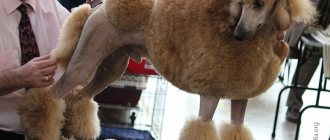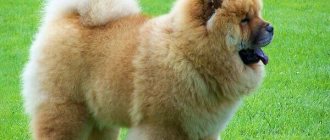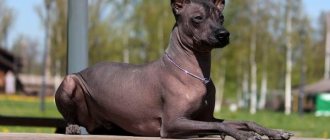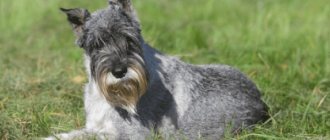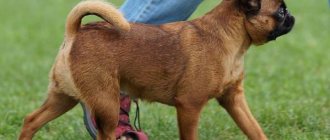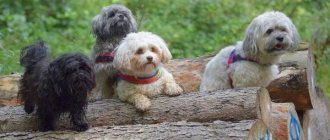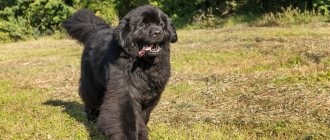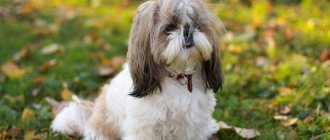During selection, new breeds of dogs appear. Not all of them are adapted to the normal life cycles of animals. For example, some types of dogs with coarse hair have lost the ability to shed. Despite this, the hair wears out and after 4-8 months loses its shine and breaks up into flakes. As a result, the animal looks unkempt and shaggy.
To bring the pet into proper shape, owners trim their dogs. This is a procedure in which dead hairs are plucked out. It is performed in salons by trained professionals. Animals are not trimmed on their own, as this requires special knowledge and skills.
- 1 The need for trimming for a dog
- 2 Haircut or trimming: what are the differences
- 3 Features of trimming
- 4 Types of trimming
- 5 Mr. Tail Recommends: Tools and Equipment for Dog Trimming
- 6 Operation algorithm
- 7 What breeds and how often do you need to trim?
The need for trimming for a dog
The extent to which it is necessary to remove the old coat can be determined by understanding its structure. In dogs, especially hunting breeds, during the process of evolution, the fur was divided into two layers. The lower one, adjacent to the skin, is soft and thick, protects from cold, parasites, and moisture. External - forms a kind of shell that reflects the attacks of winds, sharp branches and opponents.
Since pets are not exposed to aggressive environmental influences, the outer coat remains intact. Over time, it rolls down and turns into a dense, airtight cocoon. If the animal is not trimmed, after a few weeks diaper rash begins to appear on the skin, redness, itching and irritation occur, and infectious diseases caused by pathogenic flora develop.
With proper care, the dog's coat becomes clean and acquires a healthy, shiny appearance. Blood circulation in the skin improves, positively affecting all body systems and the pet’s mood.
When did grooming appear?
The grooming procedure began in ancient times. Horse owners carefully looked after their pets. Care consisted of constant combing, mane care, haircut, brushing teeth, and other hygiene procedures. Long-haired breeds needed careful care. Particular care was taken for poodles that needed extra attention from their owners. With the advent of the 20th century, the popularity of grooming has greatly increased. Today it is impossible to imagine almost any pet without grooming procedures.
Haircut or trimming: what are the differences?
Proper care of an animal's coat is practiced mainly by breeders of champion dogs who take part in exhibitions. Other owners believe that a haircut can get by. It's a delusion.
Cutting the hair at the base does not solve the problem, but makes it worse. The guard hair, which makes up the bulk of the upper cover and needs trimming, consists of two parts, the lower one is thin and soft, the upper one is dense and hard. Shaving off the top leaves a thin root structure that continues to grow.
Over time, dogs that are clipped lose their coat quality. Growing hair looks like fluff, gets dirty faster and becomes tangled. After cutting, the hair structure is not restored. With proper care, that is, by contacting a groomer, it is possible to slightly change the top coat, but it is impossible to completely reverse the process.
Short-haired dogs of wire-haired breeds do not take prizes at exhibitions and, in general, differ from their counterparts in worse appearance.
It is recommended that hair care for cocker spaniels, Yorkies, schnauzers and other representatives of hunting breeds be left to specialists from the first days the animals live in the house.
It is important to understand that cutting is a cosmetic procedure, and plucking is a hygienic procedure.
What other procedures are included in the salon services?
Grooming is not only about cutting dogs, but also about various hygiene procedures. Some salons include cupping in their services. It is carried out only in the presence of a veterinarian, when grooming services are provided by a veterinary clinic.
Nail trimming
Uncontrolled growth of claws leads to their twisting into a spiral. This structure is accompanied by damage to the pads, which is fraught with constant pain while walking and infection. Another possible danger is joint misalignment, which increases the likelihood of injury.
Overgrown claws are trimmed with regular clippers or a grinder, that is, an electric nail clipper. The latter device is safer and more effective, which is why salons usually use it.
Cleaning teeth, eyes and ears
In addition to a toothbrush and paste, special scrapers, solutions and sprays are used to clean the oral cavity. They make it easier to remove plaque and freshen your breath.
Eye treatment involves removing accumulated secretions and washing away tear tracks that change the color of the coat. Particular attention is paid to breeds with long hair, brachycephals with bulging eyes and those with folded skin.
Ear cleaning is necessary to remove excess wax, dust and dirt. The sinks are treated with a cotton swab dipped in a special lotion or plain water.
Treatment of the anal glands
The paraanal glands produce a specific secretion with an individual odor. Using it, animals “read” information about each other during acquaintance.
Blockage of this organ is fraught with stagnation of fluid and subsequent inflammation. To avoid complications, the paraanal glands are periodically cleaned externally or internally.
Ear and tail docking
Docking, or amputation of part of the ears and tail, is performed shortly after birth. This haste is associated with low sensitivity and high tissue regeneration in the first 2 weeks of life. Because of this, puppies can easily endure surgery without anesthesia, but older animals require mandatory anesthesia.
Preparation for the exhibition
Its place at the exhibition depends on the appearance of the animal, so it is better to entrust the creation of hairstyles before competitions to a professional. Acceptable options depend on the breed. Each pet needs an individual approach.
Trimming features
Trimming seems easy only when viewed from the outside. In fact, the procedure requires skill and experience. The cost in salons varies from 1800 to 3800 rubles, depending on the size of the pet. If you want to remove all the hair down to the skin, you pay an additional 2000 rubles on top of the tariff.
Some owners try to carry out the procedure themselves, which leads to bald spots in the dog's coat and an unkempt appearance of the dog.
Depending on the size of the animal and the skills of the groomer, various tools and devices are used during hair removal.
Types of trimming
The procedure has several divisions, depending on the method of execution, purpose and depth (degree of neglect of the animal).
Most dogs are trimmed by hand, carefully pulling out the outer hair. This process is called plating or rolling. Stripping involves the use of various devices.
The purpose of the procedure affects the frequency of execution. There are three main types of trimming purposes:
- Hygienic - carried out twice a year during molting periods. Most of the guard hair is removed. In preparation for the summer season, most of the undercoat is cut off, leaving 2-3 millimeters.
- Exhibition - involves preparing the animal for the event. During the process, all dead hair is carefully removed, leaving a young cover. The quality of the wool affects the jury's assessments, so this type of plucking is trusted only to specialists.
- Cosmetic - performed in the interval between molts. Shallow cleansing is preventive. With its help, they maintain the dog’s appearance and take care of skin health.
Nothing stands still; progress has also affected the field of animal care. If 20 years ago when trimming the dog was left bald, now the procedure has become more complicated and is divided into 2 types according to the depth of hair removal:
- Superficial or light - carried out monthly, removing up to 15% of the total amount of hair. If the procedure is skipped, then plucking up to 30% of the hair is performed once every 3 months. When working, they try not to touch living hairs, keeping the appearance of the animal unchanged.
- Deep or full - performed on neglected animals, when procedures have been missed for 4 months or more. All outer coat is removed by hand, the undercoat is clipped down to 2 mm with a machine. If, as a result of some process, the lower layer of the dog’s fur has changed color (for example, a black dog has become piebald), then plucking is done until the skin is bare.
Grooming is mandatory for all breeds, and the owners choose the time for performing the procedures independently, depending on the need and the general condition of the dog.
How often can you cut your hair?
There is no definite answer to this question; the frequency of dog grooming is carried out when it is needed. That is, if an animal’s fur has grown in a month, there is absolutely no reason to wait another couple of months, during which the animal will turn into an overgrown porcupine, just because some practical care guide says about the need for haircuts every three months.
The dog needs to be cut as often as necessary, for example, extra show class poodles are cut at least once a week, and sometimes twice. Of course, the animal does not grow overgrown in such a time; we are talking about maintaining the existing haircut “at the level”.
Mr. Tail recommends: tools and accessories for dog trimming
During their work, groomers use many tools and each case has its own special devices. Considering each of them, it is easy to understand that it is difficult to carry out the procedure correctly at home.
When trimming use:
| Tool | Purpose | |
| Table | Equipped with an anti-slip coating and complemented by a place for fixing the collar, it allows you to keep the animal in a safe position for it. | |
| Knife | fine-toothed | Used when pulling out the undercoat at the end of the procedure. |
| with average | Designed for work on the hull. | |
| with rough and rare | For processing guard wool, thick and coarse. | |
| Stone | Similar in structure to pumice, it is used to clean fur from dirt and remove hair at the final stage in young dogs and puppies. | |
| Stone knife | Made from sandstone and has a rough, rough surface. Safe to use, cannot injure the skin of the animal. Used for work on the ears, face, and neck area. | |
| Powder | A specially developed composition ensures better adhesion of the tool to the hair and promotes skin renewal. | |
| Fingercap | They are divided into reusable and disposable. Used to protect the technician from damage and infection during manual trimming. | |
| Pukhoderka | An auxiliary tool is used at the final stages to remove hair from the lower soft layer. | |
| Comb comb | Essential for paw hair care | |
| Trimmer | The procedure is completed and used for edging. | |
Such a variety of tools and its features of use are available only to masters. At home, it is almost impossible to perform trimming efficiently.
After treatment, the instruments are cleaned mechanically, particles of dirt are removed, then washed with water and special disinfectant solutions.
Work algorithm
The process begins by preparing the animal's fur. Owners are not recommended to wash their dog the day before. Dirt and dust allow for better grip on the tool.
Masters comb the animals with a slicker brush. Then the tangles are removed and separated manually using oils. Scissors are used in extreme cases, when hairballs cannot be processed.
Trimming takes place in 3 stages:
- First, take the tool and pluck the hair, pressing it between the working surface and the thumb. The choice of device depends on the depth of the procedure and the quality of the coat. The process starts from the back of the animal's head and moves towards the tail.
- With well-honed sharp jerks, the craftsmen pull out the wool in the direction of its growth. This is completely painless for the pet; some of them fall asleep during the lengthy procedure. Treatment of the armpits, muzzle, and thighs, that is, the most sensitive areas of the body, causes slight discomfort.
- The sequence of treatment is as follows: first clean the sides, then the back and then move on to the delicate areas.
No matter how long the trimming lasts, you cannot leave the process for the next few days. It is recommended to take breaks of 15-20 minutes so that the animal calms down and continue working until its logical conclusion.
After finishing plucking, wash your hands thoroughly and treat the used tool.
What to choose: salon or home treatments?
The main advantages of salon services are convenience and quality. Not every owner has enough free time and is able to prepare their pet for an exhibition in accordance with established rules.
The disadvantages include high prices, so with proper skill you can save at least on hygienic procedures. To do this you will need to purchase the following tools and materials:
- cleansing sprays, lotions, shampoos and conditioners;
- lint-free cotton pads necessary for cleansing eyes and ears;
- toothbrush and toothpaste;
- mechanical nail clipper or grinder;
- slicker brushes, trimming knives and combs;
- scissors and a shaving machine designed specifically for animals;
- tangle cutter
All of the above must be selected individually, taking into account the fur of the four-legged animal. Small dogs may require a separate table to make it easier to reach hard-to-reach areas.
